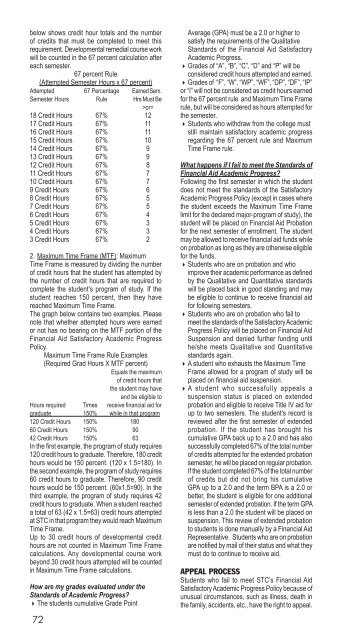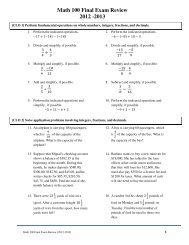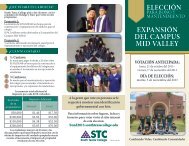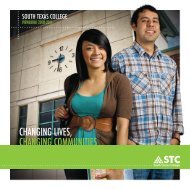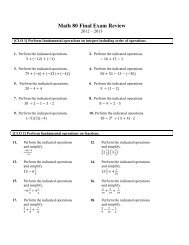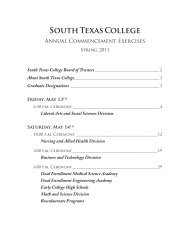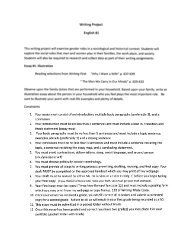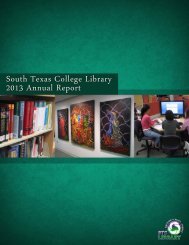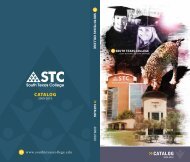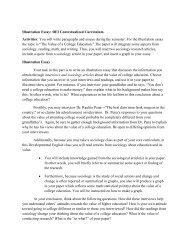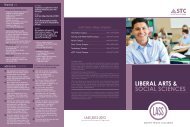Catalog 2010-2011 - South Texas College
Catalog 2010-2011 - South Texas College
Catalog 2010-2011 - South Texas College
Create successful ePaper yourself
Turn your PDF publications into a flip-book with our unique Google optimized e-Paper software.
elow shows credit hour totals and the numberof credits that must be completed to meet thisrequirement. Developmental remedial course workwill be counted in the 67 percent calculation aftereach semester.67 percent Rule(Attempted Semester Hours x 67 percent)Attempted 67 Percentage Earned Sem.Semester Hours Rule Hrs Must Be>or=18 Credit Hours 67% 1217 Credit Hours 67% 1116 Credit Hours 67% 1115 Credit Hours 67% 1014 Credit Hours 67% 913 Credit Hours 67% 912 Credit Hours 67% 811 Credit Hours 67% 710 Credit Hours 67% 79 Credit Hours 67% 68 Credit Hours 67% 57 Credit Hours 67% 56 Credit Hours 67% 45 Credit Hours 67% 34 Credit Hours 67% 33 Credit Hours 67% 22. Maximum Time Frame (MTF): MaximumTime Frame is measured by dividing the numberof credit hours that the student has attempted bythe number of credit hours that are required tocomplete the student’s program of study. If thestudent reaches 150 percent, then they havereached Maximum Time Frame.The graph below contains two examples. Pleasenote that whether attempted hours were earnedor not has no bearing on the MTF portion of theFinancial Aid Satisfactory Academic ProgressPolicy.Maximum Time Frame Rule Examples(Required Grad Hours X MTF percent)Equals the maximumof credit hours thatthe student may haveand be eligible toHours required Times receive financial aid forgraduate 150% while in that program120 Credit Hours 150% 18060 Credit Hours 150% 9042 Credit Hours 150% 63In the first example, the program of study requires120 credit hours to graduate. Therefore, 180 credithours would be 150 percent. (120 x 1.5=180). Inthe second example, the program of study requires60 credit hours to graduate. Therefore, 90 credithours would be 150 percent. (60x1.5=90). In thethird example, the program of study requires 42credit hours to graduate. When a student reacheda total of 63 (42 x 1.5=63) credit hours attemptedat STC in that program they would reach MaximumTime Frame.Up to 30 credit hours of developmental credithours are not counted in Maximum Time Framecalculations. Any developmental course workbeyond 30 credit hours attempted will be countedin Maximum Time Frame calculations.How are my grades evaluated under theStandards of Academic Progress?4 The students cumulative Grade Point72Average (GPA) must be a 2.0 or higher tosatisfy the requirements of the QualitativeStandards of the Financial Aid SatisfactoryAcademic Progress.4 Grades of “A”, “B”, “C”, “D” and “P” will beconsidered credit hours attempted and earned.4 Grades of “F”, “W”, “WP”, “WF”, “DP”, “DF”, “IP”or “I” will not be considered as credit hours earnedfor the 67 percent rule and Maximum Time Framerule, but will be considered as hours attempted forthe semester.4 Students who withdraw from the college muststill maintain satisfactory academic progressregarding the 67 percent rule and MaximumTime Frame rule.What happens if I fail to meet the Standards ofFinancial Aid Academic Progress?Following the first semester in which the studentdoes not meet the standards of the SatisfactoryAcademic Progress Policy (except in cases wherethe student exceeds the Maximum Time Framelimit for the declared major-program of study), thestudent will be placed on Financial Aid Probationfor the next semester of enrollment. The studentmay be allowed to receive financial aid funds whileon probation as long as they are otherwise eligiblefor the funds.4 Students who are on probation and whoimprove their academic performance as definedby the Qualitative and Quantitative standardswill be placed back in good standing and maybe eligible to continue to receive financial aidfor following semesters.4 Students who are on probation who fail tomeet the standards of the Satisfactory AcademicProgress Policy will be placed on Financial AidSuspension and denied further funding untilhe/she meets Qualitative and Quantitativestandards again.4 A student who exhausts the Maximum TimeFrame allowed for a program of study will beplaced on financial aid suspension.4 A student who successfully appeals asuspension status is placed on extendedprobation and eligible to receive Title IV aid forup to two semesters. The student's record isreviewed after the first semester of extendedprobation. If the student has brought hiscumulative GPA back up to a 2.0 and has alsosuccessfully completed 67% of the total numberof credits attempted for the extended probationsemester, he will be placed on regular probation.If the student completed 67% of the total numberof credits but did not bring his cumulativeGPA up to a 2.0 and the term BPA is a 2.0 orbetter, the student is eligible for one additionalsemester of extended probation. If the term GPAis less than a 2.0 the student will be placed onsuspension. This review of extended probationto students is done manually by a Financial AidRepresentative. Students who are on probationare notified by mail of their status and what theymust do to continue to receive aid.APPEAL PROCESSStudents who fail to meet STC’s Financial AidSatisfactory Academic Progress Policy because ofunusual circumstances, such as illness, death inthe family, accidents, etc., have the right to appeal.


